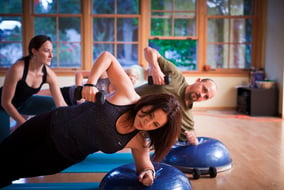In the midst of the worldwide COVID-19 pandemic, what’s your sleep routine looking like these days? During this time of uncertainty, getting quality sleep is more important than ever.
Sleep is the time when your body resets, renews, and rejuvenates itself. Your immune system is strengthened during sleep and your mental and emotional capacity is regenerated.
Taking time to assess your sleep routine is an optimal way to set yourself up for daily success now, while in isolation, and in the future.
Likely, your sleep routine falls into one of three categories:
- Sleep routine? What’s that?
- I had a good routine that is now slightly off.
- My sleep is better than ever!
Let’s look at each of these behaviors and how we might learn from them.
 What is a sleep routine and why is it important?
What is a sleep routine and why is it important?
First, let’s define what a sleep routine is. A sleep routine, or sleep hygiene, is a set of healthy behaviors you do before sleep and when you awaken, to improve your ability to get quality sleep. The quality of sleep you get each night affects your physical, mental, and emotional health.
Not getting quality sleep is linked to many chronic diseases and conditions such as type 2 diabetes, heart disease, obesity, and depression. According to the CDC, not getting quality sleep can lead to motor vehicle crashes and mistakes at work.
The quality of your sleep is what really matters here. Your sleep is not quality when you wake up feeling exhausted, have a low mood upon waking and throughout the day, have poor mental focus, and experience excessive cravings — even if you slept 8 hours.
On the other hand, quality sleep is when you fall asleep within 30 minutes, sleep soundly through the night without waking up more than once, and if you do wake up, you are able to fall back asleep within 20 minutes.

 Changes to your sleep routine
Changes to your sleep routine
Perhaps you’ve noticed your routine is off due to changes to your schedule or stress level. Have you noticed yourself slipping back into old habits? No worries, by taking a close look at what you’re doing (or not doing), you can get back on track to getting the quality sleep you’ve grown accustomed to.
Ask yourself these questions:
What was my sleep routine before these changes?
What parts of my routine do I want to re-establish?
Are there parts of my old routine I need to change/improve?
What is one small thing I can do to get back on track?
 How to establish a sleep routine
How to establish a sleep routine
Some of you may feel like sleep is better than ever! You’ve established a set of behaviors (or recently began) that are allowing you to experience consistent, quality sleep. We can learn from you!
Here are healthy behaviors to establish a sleep routine:
- Be consistent. Go to bed at the same time each night and get up at the same time each morning, including on the weekends.
- Set a bedtime that is early enough for you to get at least seven hours of sleep.
- Make sure your bedroom is quiet, dark, relaxing, and at a comfortable temperature.
- Establish a relaxing bedtime routine that starts 60-90 minutes before you plan to be asleep.
- Limit exposure to bright light in the evenings including electronic devices, such as TVs, computers, and smart phones.
- Avoid large meals, caffeine, and alcohol before bedtime.
- Get some exercise. Being physically active during the day can help you fall asleep more easily at night. Your usual outlets, such as the gym, are probably closed right now. Consider walking outside and indoor resources such as home fitness equipment, bodyweight training, stairs, and online fitness videos.
- Reduce fluid intake before bedtime.
If this is new to you, start with two to three of these behaviors and build your way up. In no time, you’ll find yourself sleeping well and recognizing the difference.
If you just need to get back on track, you now know what to do to regain your footing.
And if your sleep is great, keep doing what you’re doing! Your solid foundation of behaviors is helping to pull you through during these unprecedented times.
Sign up
Join our email list to receive the latest open positions, Vera Careers news, and more.





